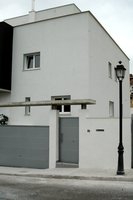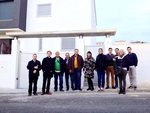Insulation and temperature profile in an extreme climate
India is one of the few countries worldwide that has all climates, from glacial in the Himalayas to hot and arid in the west, as well as tropical humid in the coastal south.Similarly, Granada, in Spain, is known for its extreme temperature variations in Europe. It lies at the foot of the Sierra Nevada (Snow Mountains) at an altitude of 730 m.
In 2011, Francisco M. (Paco) built his passive house with Styro Stones in Granada. Due to personal reasons he could move into the house only 2 years later.
Meanwhile, to test the performance and efficiency of his house, Paco measured and recorded the internal and external variations in temperature of the completed dwelling and made a very detailed study about his house.
At the end of this page you can download the complete study that Paco made.
Temperature profile of 22nd February
Due to the excellent insulation values of the completed Styro Stone shell, there is a constant comfortable temperature inside the house. During the winter months, heat produced by the occupants, i.e. body heat and daily use of electrical appliances such as lighting, TV, etc. is sufficient to generate a comfortable, cosy ambience.
blue : Temperature outside
red : Temperature in the basement
white : Temperature on 1st floor
green : Temperature on 2nd floor
From 22nd February until 8th March
Basically, it requires less energy to keep a house warm, than to cool it. This is due to the warmth that is produced by the inhabitants and the electrical devices. However, the requirement for Air Conditioning (by ACs) can and is reduced dramatically.
The study will show what more Paco has done to keep his house cool and protected against the bright sunshine, which is harsher than in most Indian regions, because there is almost no pollution.
Visit of the Local Council of Architects
On 17.12.13 the local council of architects came to review the passive house built by Paco and to learn from his experience. Incidentally, the fist passive house in Spain was built in 2000 using Styro Stones. Interest for this quality of housing is increasing rapidly in Spain and other Mediterranean countries.Local governments are now more aware that they need to reduce CO² emissions which are harmful to the ozone layer. In hotter climates, the ACs significantly contributes to these emissions.
|
Please download the complete study (71 pages with a lot of detailed pictures) which we have translated into English |




